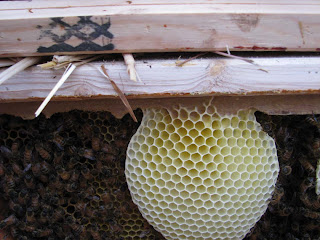I was very alarmed to find a drone scuttling around in the grass under the hive the other day. That in itself is not an unusual event. Drones are expendable and are often unceremoniously tipped out the door of the hive when more room/food/cells are needed.
 |
| These were full drone cells last week, now they are cleaned out and being used.I am watching to see what develops here. Drone cells are very attractive to mites, so drones are commonly higher in mite infestations. |
What
was alarming was the comparatively giant Varroa Mite that was hanging on the belly of the drone. Seriously, if that mite was on
my belly it would be the size of a small cat!
I took these pictures and then went on the search for what to do.
 |
| Mite is circled, click to enlarge this photo |
|
|
I have found this series of videos from the
Florida State University on bee diseases to be concise and exceptional in their information content. Every time I watch one I learn something new.
I found a few other up to date sources on the web that also confirmed that screened bottoms are the way to go. My hives already have screened bottoms.
The next thing to do, it seems, is to make some "grease patties". Here is a recipe I adapted from a much larger recipe from the West Virginia University (
go here for a pdf with more detailed direction on the type of salt and where to place patties). I cut the recipe down because I didn't need enough for 10 hives.
 |
| That's "wintergreen oil" last on the list |
The sugar and salt encourage the bees to eat the pattie. The oil in it gets on the bee's hairs and makes it difficult to hold onto for the mites.
It also has wintergreen oil in it which is supposed to upset the mites and cause them to run around, increasing the chances that they will fall off the bees and through the screened bottom, never to be seen again.
Caution: do not add more wintergreen oil than this. It will cause the bees to attack and kill the queen because they will not be able to smell her. In this recipe, more is
not better. Also do not follow older recipes which advocate antibiotics being added. New studies have shown this only harms the bees in the long run by making anything the antibiotic treats, resistant.
 | |
| I didn't even try to stir this stuff with a spoon, it's just too stiff. I just squished it in my hands like play dough, scraping the bottom several times in the process. |
 |
| Grease pattie the size of a small hamburger. |
 |
| You can see the screened bottom of the hive here. I had a syrup feeder in the hive so I replaced the jar with the grease pattie and put one on the side for good measure. |
Only time will tell if this is an effective method for my top bar hives.
I am keeping a close eye on them. I am on the fence about using anything stronger to deal with the mites. There are a few more organic methods to use. But the danger is in Fall when the bee population drops for winter and mite populations spike. I have heard several accounts of seemingly healthy hives suddenly being a dead pile of bees, and apparently this is the number one sign of a critical Varroa Mite infestation.
 |
| The livestock salt from the feed store is too coarse for the grease patties so you have to whurr it up in a blender. |
I am hoping that the mites only achieved a foothold in the first place because of the stress the hive was under from of the very wet spring/summer we are having, and that as the weather improves and the bees now are not so crowded (because they swarmed twice) they will become healthy enough overcome the mites again.
 |
| Drone next to the mite |
Apparently all hives have mites these days. But it's all about
how many mites they have that determines the health of the hive.














